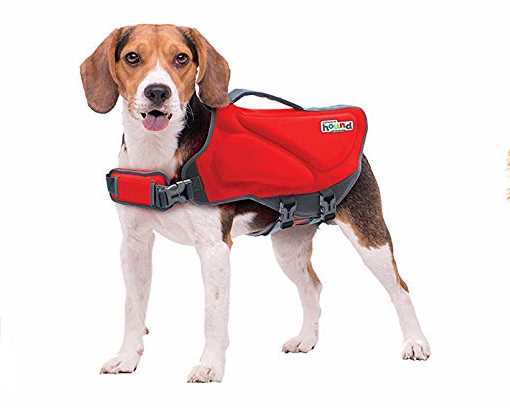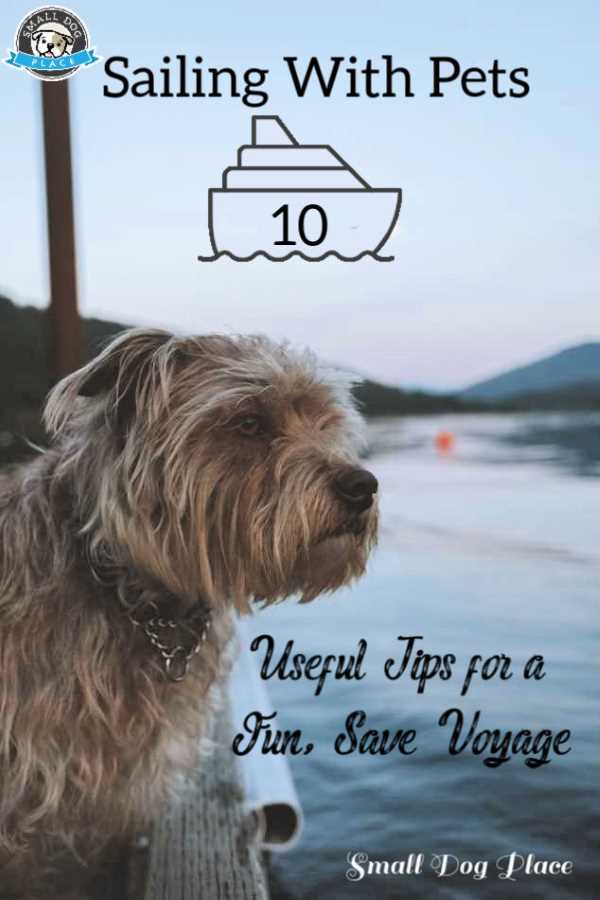- Small Dog Place Home
- Lifestyle
- Sailing With Pets
10 Useful Tips for Sailing With Pets On Board
Sailing with Pets by Ashley Halsey |Updated 02-08-2021
Whether you’re heading out on a family sailing trip or climbing aboard a yacht for a longer trip, you may need to consider how to handle and care for your pet while you’re away.
Of course, you can always leave them at home, find a pet-sitter or have them stay in a doggy-day-care facility – but bringing your furry friend with you can be a great idea!
 Sailing with Pets requires a bit of planning the rewards are great.
Sailing with Pets requires a bit of planning the rewards are great.It can be a lot of extra fun to have your cat or dog with you and your family on your next sailing trip, but you should also be aware of the necessary precautions you’ll need to take to keep everyone on board happy and safe.
10 Foolproof Tips for Sailing with Pets
1. Ease Them into It
The first thing to bear in mind when sailing with pets – if your pet has never been out at sea before – is to ease them into the experience. You never know how your pet will react to being on a boat, so start by taking them on short trips to start with so they can get used to how it feels.
2. Assure Proper Training Well in Advance
Training them in advance for how to behave on board is also a good idea, so they will be easier to handle when you do take a trip.
Jean Garrett, a travel writer at Writinity.com and Lastminutewriting.com, talks about training for travelling with your pet: “Just like in any new situation, you need to properly train your pet before you take them on a trip.
Whether you are flying, driving, or sailing, they may not be comfortable the first time they experience it. They may panic, get sick, or be very scared and timid. Practice the trip with them before you embark on a longer journey, so you are prepared for how they will react and can comfort them and train them accordingly.
You may also need to consider various medications, such as for seasickness or carsickness, and plan for how to let them do their business throughout the trip, which may require extra training.”
3. Research Travel Regulations and Basic Precautions
If you are travelling on a yacht or other boat trip that is not your own, make sure to check with the company or owner about their rules and allowances for having pets on board.
If you are taking your pet on a trip with you on a yacht, ensure you know the relevant laws and requirements for travelling with a pet in the area you will be visiting or travelling through.
This includes making sure they are up to date on their vaccinations, as well as finding out what other vaccinations they may need for the area you will be visiting. Find out what the travel regulations are by contacting local authorities to learn what documentation you need for your pet.
Check plenty of time in advance as it can take time to apply for documentation, and make sure you get your pet micro-chipped! Aside from just being a good idea in general, many countries require your pet to have a micro-chip.
Of course, you should have a collar with a tag with full contact information in case you lose them over board and another boater finds them, so they can return your precious pet to you!
4. Pet-Proof the Boat for Safety
 Sailing with Pets Can be Fun for the Whole Family
Sailing with Pets Can be Fun for the Whole FamilyBefore bringing your pet on board for the first time, you need to essentially child-proof it.
‘Pet-proofing’ should include making sure there are no dangerous spots that your pet could injure themselves on if they start to panic, which is fairly common, especially on their first trip out. You might have to adapt the companionway stairs, such as by installing a plank so they can get down it.
5. Create a Safe Pet Space They Can Call Their Own
You should also make sure they have a ‘safe’ place to hide if they are scared, ideally an enclosed space that’s quiet, dark, and secluded. You can also fill this space with comforts from home, like your pet’s bed, blanket, toys, etc.
This is important for any pet – even if they are usually very comfortable on board the boat, they may become agitated, tired, or frightened and need some time and space where they feel comfortable and safe without worrying about the water or the weather.
6. Install Lifeline Netting for Extra Safety
Unlike if a person falls overboard, you pet will likely be unable to call for help, so you need to keep your eye on them at all times. They may see something they want to chase, like a bird, and jump into the water after it, or they may simply slide or fall under the lifelines.
Consider adding netting around the boat to add an extra level of protection to the lifeline, which is a popular option.
7. Accustom Your Dog to Wearing a Harness and Leash
 Accustom your dog to wearing a harness before setting sail.
Accustom your dog to wearing a harness before setting sail.Secure your pet to the cockpit if you are still hesitant about letting them freely wander around.
Use a leash and a harness to keep them safe – keeping a harness on at all times is also a good idea to help with helping your pet if they fall into the water, as it is easier and safer, since a collar can slip over their heads or choke them when you are pulling the back onto the boat.
8. Insist on a PFD When Sailing With Pets
 PFD (Pet Floatation Device)
PFD (Pet Floatation Device)Keeping Your Pet from Falling Overboard by insisting on them Wearing a PFD (Pet Floatation Device)
Just like every person on board should have a life vest, your pets should also be kitted out to keep them afloat if they do fall overboard. This is called a PFD (pet floatation device) and can be lifesaving. Consider adding reflective tape or a light (waterproof, of course) to the PFD, so you can easily locate them even in the dark.
9. Avoid Seasickness, Dehydration, and Overheating
Keeping your pet hydrated goes without saying, but there are a variety of ways to do this. They may not be comfortable enough on the boat to seek out their water bowl, so make sure you have water on hand when they need it. If they don’t seem to want any water, they may simply be too seasick, so try offering them some ice to lick.
You can also get seasickness medication for pets if they struggle with this and pet-friendly sunscreen to keep them from burning or overheating. Keep them well-shaded throughout the trip and educate yourself in advance on the signs of overheating and dehydration in your pet.
10. Train Them Where to Do Their Business
Before setting sail with your family, furry friend in tow, you will need to think about how – and, more importantly, where – they are going to do their business. You may be able to train your pet to do their business on board, using a range of different techniques.
For animals like cats, for example, who are already trained to go in a litter box, this is going to be considerably easier, as you can simply bring the litter box on board with you. For dogs, however, you’ll need to find a method that works for you.
This may take a little trial and error and may not end up working for some pets, in which case you will just have to plan on taking shorter trips so they can do their business on land as usual.
One option is to train your pet to use a litter box, while others choose to use newspapers, or even a small patch of artificial grass to help them feel comfortable going to the bathroom while on board.
Regardless of the method you choose, you should always place it below deck for stability and train your pet to use it on land initially, to ease them into it.
As George Voyles, a pet blogger at Draftbeyond.com and Researchpapersuk.com, says,
“Bringing your pet out on a sailing trip with you and your family can be a wonderful way to make your trip even more fun and they can keep you company if you are sailing alone – so long as you are fully prepared to keep you, your family, and your beloved pet safe, secure, happy and healthy!”
Final Words: Sailing with Pets
So long as you follow these tips for keeping your pet safe and happy while on a sailing trip, there’s no reason they won’t have the time of their life – and bring a little extra excitement and joy to you and your family while you are out at sea.
Author Bio: Sailing with Pets
Ashley Halsey is a professional writer for Luckyassignments.com, and Gumessays.com who has been involved in countless projects across the country. Ashley is a mother of two and, in her free time, she enjoys traveling, reading, and attending business training courses.
About Janice (author and voice behind this site)
Janice Jones has lived with dogs and cats for most of her life and worked as a veterinary technician for over a decade. She has also been a small-breed dog breeder and rescue advocate and holds academic training in psychology, biology, nursing, and mental health counseling. Her work focuses on helping dog owners make informed, responsible decisions rooted in experience, education, and compassion.
When not writing, reading, or researching dog-related topics, she likes to spend time with her six Shih Tzu dogs, her husband, and her family, as well as knitting and crocheting. She is also the voice behind Miracle Shih Tzu and Smart-Knit-Crocheting
Does This Article Deserve Your Thumbs Up?
We always appreciate your support and encouragement. Your thumbs up means so much to us. Please like this article.
If you find this page or any page on Small Dog Place Helpful, or useful in anyway, I'd love it if you would click the small heart found on the bottom right of each page.
You can also share or bookmark this page -- just click on the:

Free Monthly Newsletter
Sign Up for Our Free Newsletter and get our Free Gift to You.
my E-book, The Top 10 Mistakes People Make When Choosing a Dog (and how to avoid them)







